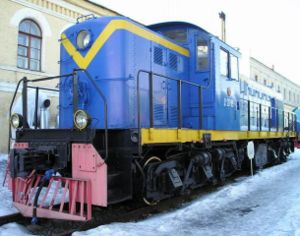
ALCO RSD-1
Encyclopedia

American Locomotive Company
The American Locomotive Company, often shortened to ALCO or Alco , was a builder of railroad locomotives in the United States.-Early history:...
(ALCO). This model was a road switcher
Road switcher
A road switcher is a type of railroad locomotive used for delivering or picking up cars outside of a railroad yard. Since the road switcher must work some distance away from a yard, it needs to be able to operate at road speeds, it must also have high-visibility while it is switching, and it must...
type rated at 1000 hp and rode on three-axle trucks
Bogie
A bogie is a wheeled wagon or trolley. In mechanics terms, a bogie is a chassis or framework carrying wheels, attached to a vehicle. It can be fixed in place, as on a cargo truck, mounted on a swivel, as on a railway carriage/car or locomotive, or sprung as in the suspension of a caterpillar...
, having a C-C wheel arrangement. It was often used in much the same manner as its four-axle counterpart, the ALCO RS-1
ALCO RS-1
The ALCO RS-1 was a 4-axle diesel-electric locomotive built by Alco-GE between 1941 and 1953 and the American Locomotive Company from 1953 to 1960. This model has the distinction of having the longest production run of any diesel locomotive for the North American market.The carbody configuration of...
, though the six-motor design
Traction motor
Traction motor refers to an electric motor providing the primary rotational torque of a machine, usually for conversion into linear motion ....
allowed better tractive effort at lower speeds, as well as a lower weight-per-axle.
There were three different specifications issued that covered the RSD-1 model; E1645 and E1646 were for wartime production for the US Army, while E1641 was a post-war order for the Mexican National Railways (Ferrocarriles Nacionales de México
Ferrocarriles Nacionales de México
Ferrocarriles Nacionales de México, was Mexico's state owned railroad company from 1938 to 1998, and prior to 1938 a major railroad controlled by the government that linked Mexico City to the major cities of Nuevo Laredo and Ciudad Juárez on the U.S. border...
).
Seventy of the RSD-1s were shipped overseas to the Soviet Union
Soviet Union
The Soviet Union , officially the Union of Soviet Socialist Republics , was a constitutionally socialist state that existed in Eurasia between 1922 and 1991....
during World War II
World War II
World War II, or the Second World War , was a global conflict lasting from 1939 to 1945, involving most of the world's nations—including all of the great powers—eventually forming two opposing military alliances: the Allies and the Axis...
, where they were classed as the Soviet Railways Да20 (Da20) class, as part of the Allied war effort. These locomotives were also used on the Trans-Iranian Railway
Trans-Iranian Railway
The Trans-Iranian Railway was a major railway building project started in 1927 and completed in 1938, under the direction of the Persian monarch, Reza Shah, and entirely with indigenous capital. It links the capital Tehran with the Persian Gulf and Caspian Sea...
. The Soviets subsequently kept many of the RSD-1s after the war, adopting the design to form the basis of their own line of diesel locomotives. A dozen RSD-1s were sunk en route to the Soviet Union when the ship they were on was torpedoed by a German U-boat
U-boat
U-boat is the anglicized version of the German word U-Boot , itself an abbreviation of Unterseeboot , and refers to military submarines operated by Germany, particularly in World War I and World War II...
.
The first 13 RS-1s were requisitioned by the US Army, returned to ALCO and rebuilt to RSD-1s #8000-8012 for use on the Trans Iranian Railroad. This effort was to supply the Soviet Union. See the RS-1 article for the identity of the first 13 RSD-1s.
Specification E1645
| Railroad | Quantity | Road Numbers | Notes |
|---|---|---|---|
| United States Army | |
8013–8056 | |
Specification E1646
| Railroad | Quantity | Road Numbers | Notes |
|---|---|---|---|
| United States Army | |
8600–8629 | to Soviet Railways Да20-1 to Да20-30 |
| United States Army | |
8630–8640 | lost in U-Boat attack |
| United States Army | |
8641–8648 | to Soviet Railways Да20-31 to Да20-38 |
| United States Army | |
8649 | lost in U-Boat attack |
| United States Army | |
8650-8679 | |
| United States Army | |
8680–8699 | to Soviet Railways Да20-39 to Да20-58 |
Specification E1641
| Railroad | Quantity | Road Numbers | Notes |
|---|---|---|---|
| Ferrocarriles Nacionales de México Ferrocarriles Nacionales de México Ferrocarriles Nacionales de México, was Mexico's state owned railroad company from 1938 to 1998, and prior to 1938 a major railroad controlled by the government that linked Mexico City to the major cities of Nuevo Laredo and Ciudad Juárez on the U.S. border... |
|
5700–5705 | |

